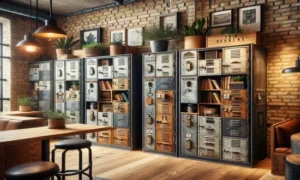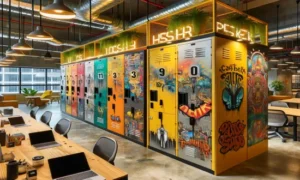Introduction
Welcome to the world of modern decor, where industrial style stands out as a strong trend. Characterized by its striking personality, this style has its roots in the large factories and warehouses of the last century.
The rugged simplicity of industrial workspaces is transformed into sophisticated and desirable design elements. Among them, the locker-style cabinet emerges as a key piece.
It stands out not only for its functionality, but also for its ability to add an authentic and creative touch to any environment.
In this article, we’ll explore the origins of the industrial style. We’ll highlight the importance of integrating pieces that combine history and character, such as the locker-style wardrobe. We’ll also provide a step-by-step guide to creating your own, enriching your decor with a unique element.
Get ready to explore the creative potential of industrial style in your own home by adding pieces that not only beautify the space, but also tell a story.
The Essence of Industrial Style
Industrial style is a celebration of the unfinished, the functional and the structural. It is characterized by the liberal use of raw, unfinished materials such as metal, wood and concrete, with pipes, beams and other structural elements proudly displayed as part of the interior design. The predominant colors are neutral and uncluttered – think grays, blacks, whites and natural wood tones – creating a backdrop that emphasizes the texture and shape of the materials.
This style isn’t just about choosing the right furniture; it’s a holistic approach that transforms functional spaces into livable works of art, where every piece tells a story. In this context, the locker-style cabinet is more than just a storage item. It invokes the nostalgia of old industrial and school lockers, bringing with it a sense of order, durability and history. Its sturdy metal frame, vented doors and swing-out locks not only serve practical purposes, but also add depth and visual interest to the décor, making it a perfect complement to the industrial style. By integrating a locker-style cabinet into your space, you’re not only adding a practical storage element, but you’re also embracing the essence of industrial design, celebrating beauty in utility and history.
Planning and Design
Before we dive into the wonders of construction, it’s crucial to start with a solid plan for your locker. The first step is to determine where this iconic piece of furniture will fit into your space. Whether it’s in a spare corner of your living room, as a surprise feature in your bedroom, or even as a practical solution to clutter in your hallway, the placement will determine many aspects of the design.
Once you’ve decided on a space, think about the purpose of the closet. Will it be used to store coats and shoes, tools and equipment, or perhaps to organize books and decorative items? This decision will directly influence the number of compartments, the dimensions, and any special features you might want to include, such as adjustable shelves, internal hooks, or even a locking system.
When designing your locker, consider the dimensions of the available space and how people will interact with it. Ergonomics and accessibility are key; make sure the locker is at a comfortable height for all users and that there is enough space to open and close the doors without obstruction. Choosing a design that complements the surrounding environment while maintaining functionality is the perfect balance to strike when planning your locker style locker.
Necessary Materials and Tools
Building a locker that not only serves as a storage element but also as a statement piece in your space starts with choosing the right materials. You’ll need sheet metal, which is the backbone of industrial design, providing durability and authenticity. You might also consider including wood elements for internal shelving or external accents, adding warmth and contrast to the cold metal.
The tool list is equally important. Basic equipment such as a drill, screwdriver, saw (for cutting wood, if applicable), and welding equipment (for joining metal parts) will be essential. Don’t forget safety equipment such as gloves, goggles, and masks to ensure a safe construction process.
When choosing materials, think about the color palette and textures that will complement your space. Metals with raw or weathered finishes reinforce the industrial vibe, while reclaimed or recycled woods can add a layer of history and sustainability to your design. Remember, each material and tool you choose should not only serve a functional purpose, but also contribute to the visual narrative of your locker.
Step by Step Assembly
Building a locker is an exciting journey that involves skill, creativity, and a little sweat equity. With the materials and tools at hand, you’re ready to turn your vision into reality. Here’s a step-by-step guide to help you through the process:
- Preparation and Organization: Before you begin, prepare your workspace. Make sure the area is spacious, well-lit, and ventilated. Organize your materials and tools so that everything is easily accessible. This not only saves time, but also prevents accidents.
- Measuring and Cutting: Based on your chosen design, measure and mark the metal and/or wood sheets for your cabinet parts. Use your saw to cut the wood as needed, and if you’re using metal, the appropriate cutting equipment. Remember, “Measure twice, cut once” is the mantra to follow to avoid mistakes.
- Frame Assembly: Start by assembling the outer frame of the cabinet. If you’re using metal, you may need to weld the pieces together. Otherwise, use bolts and nuts for a sturdy assembly. Make sure all corners are aligned and the frame is level.
- Adding Compartments and Shelves: With the outer frame in place, it’s time to add the inner compartments and shelves. Use metal or wood dividers, depending on your design, and secure them in place with screws or welding. Adjust the height of the shelves to suit your storage needs.
- Doors and Locks: Install the doors, making sure they fit snugly and open and close without obstruction. Locks can be added for extra security, especially if you plan to store valuable items.
- Finish: Sand down any rough edges, especially if you’re working with wood. Apply a coat of primer, then paint your cabinet in your desired color. For a true industrial touch, consider leaving the metal exposed or using a paint that mimics an aged metal texture.
- Inspection and Adjustments: Inspect the entire structure for any weak points or instability. Adjust or tighten screws as necessary. Check that all doors operate properly and that shelves are secure.
- Final Positioning: Once the cabinet is complete, carefully move it to the desired location in your home. Use floor protectors to prevent scratches and ensure the cabinet does not damage your floor.
Tips for Durability and Stability:
- When assembling, always opt for robust connections. Longer screws and well-done welds will increase the strength of your cabinet.
- For added stability, secure the cabinet to the wall with brackets, especially if it is tall or intended to store heavy items.
- Treat metal with anti-corrosion solutions and seal wood with varnish or sealer to protect against environmental damage.
By following these steps, you'll create not only a functional cabinet, but a statement piece that brings charm and industrial character to your space.
Personalization and Creative Details
The true charm of a locker-style cabinet lies in its ability to tell a unique story through creative, personalized details. Start with the paint: choose colors that complement your space or opt for a distressed finish for an authentic vintage feel. Themed decals, such as ID numbers or graphic signs, can add a playful element while still maintaining the industrial vibe.
Pulls are small details that make a big difference. Swap out standard pulls for more robust or vintage-style options to reinforce the industrial aesthetic. You can also incorporate elements like exposed metal piping as hangers or brackets, adding functionality while maintaining style.
Metal plates, whether they’re nameplates or decorative plates, can add an industrial finish to your locker. Place them strategically to emulate the feel of an old factory or school locker. These finishing touches not only add to the authenticity of your locker, but they also transform the piece into a conversation piece and a reflection of your creativity and personal style.
Where to Find a Locker Style Wardrobe
Locker Style Cabinets in Urban Coffee Shops
In modern urban coffee shops, locker cabinets are being reinvented as multifunctional pieces of furniture that combine aesthetics with practicality. Imagine walking into a cozy coffee shop where lockers are used not only to store coffee supplies like beans and equipment, but also as displays for a selection of books, plants and local art.

These cabinets, with their metal doors and rustic finish, are strategically positioned along an exposed brick wall, creating a visual contrast that captures the essence of industrial design. The use of vintage pulls and personalized nameplates on each compartment adds a touch of charm and history, inviting customers to explore each niche. Ambient lighting, with industrial-style pendant lights, highlights the cabinets, transforming them into a centerpiece of the space, where functionality meets art.
Lockers in Coworking Spaces
Coworking spaces are known for their vibrant, collaborative atmosphere, and locker-style cabinets play a significant role in this dynamic. In this environment, lockers are designed to reflect the energy and creativity of the space, with bright colors and custom designs that encourage inspiration. They are strategically placed, serving not only as secure storage for electronics and important documents, but also as partitions that create private workspaces in an otherwise open space.
Each locker is equipped with electronic locks, ensuring the security of users’ personal items. The clever use of materials, such as the combination of metal and recycled wood elements, reinforces the space’s commitment to sustainability. The inclusion of street art and graffiti on the locker doors adds an element of personal expression, transforming each locker into a canvas for the local community of artists, and reinforcing the coworking space’s unique identity.
Final Considerations and Maintenance
To ensure the longevity of your locker, keep it clean and dry to avoid moisture build-up that can lead to rust. Remember to touch up the paint and tighten the screws periodically. We encourage you to explore your creativity by making adjustments and additions that reflect your personality and unique style.

